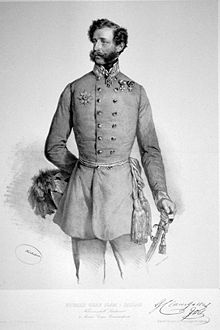Eduard Clam-Gallas
Eduard Clam-Gallas | |
|---|---|
 Lithograph by Josef Kriehuber, 1849. | |
| Born | 14 March 1805 Prague |
| Died | 17 March 1891 (aged 86) Vienna |
| Allegiance | |
| Years of service | 1823–1866 |
| Rank | General der Kavallerie |
| Unit | Cavalry |
| Commands | 1st Transylvanian Army Corps, 1st Bohemian Army Corps |
| Battles / wars | First Italian Independence War Battle of Santa Lucia Battle of Vicenza Battle of Custoza Hungarian Revolution of 1848 Battle of Segesvár Second Italian War of Independence Battle of Magenta Battle of Solferino Austro-Prussian War Battle of Podol Battle of Münchengrätz Battle of Gitschin |
| Awards | |
| Relations | Clothilde von Dietrichstein (1828 – 1899) |
| Other work | Member of the Aulic Council |
Count Eduard Clam-Gallas (14 March 1805, in Prague – 17 March 1891, in Vienna) was an Austrian general. He was the eldest son of Count Christian Christoph Clam-Gallas (1771–1838), patron of Beethoven, and Countess Josephine Clary-Aldringen (1777–1828).
Career
In 1823 Clam-Gallas joined the Army, at first as a Rittmeister (Captain) of the 1st Cavalry Regiment in 1831, then Commander (1835), Colonel (1840) and General in Prague (1846).
In 1848, called to Italy under the orders of General Joseph Radetzky, he commanded a brigade which distinguished itself at Santa Lucia, Vicenza and the Battle of Custoza. He was decorated with the Military Order of Maria Theresa and promoted to Field Marshal Lieutenant (equivalent of two-star general).
In April 1849 he became commander of the Transylvanian Army Corps which needed to return to Turkey (7,000 infantry, 1,600 horse and 36 cannon). At the beginning of July he was moving into Hungary to Template:Lang-hu (now Template:Lang-ro), to support Alexander von Lüders on the right flank. In this month there were a few battles between Lüders, Józef Bem and Sándor Gál. During the Transylvanian summer campaign, Clam-Gallas was defeated by Bem, but after that was able to defeat Sándor Gál and his Székels Army. After occupying Székely Land he joined Lüders and together they defeated Bem at Segesvár.
In 1850, he was head of the I Army Corps of Bohemia in Vienna, and in the Second Italian War of Independence (1859) took part in the Battle of Magenta and the Battle of Solferino. This army corps was one of the first to be repelled, but this failure had no personal consequences for Clam-Gallas, who was promoted to General der Kavallerie.
In 1861 he was admitted to the Aulic Council before becoming, in 1865, Imperial Hofmeister.
At the start of the Austro-Prussian War Clam-Gallas, still in command of I Corps, was given command of units (60.000 men) detached from North Army, called Iser Army and consisting out of his own I Corps, the retreating Royal Saxon Army Corps, the Austrian brigade evacuated out of Holstein, and an Austrian light cavalry division. In the course of the War, he suffered defeats at Podol, Münchengrätz and Jičín. After reuniting his force with North Army under Ludwig von Benedek he reverted to command of I Corps. He was relieved of his command and replaced by Count Leopold Gondrecourt in the early morning of 3 July 1866 and thus took no part in the defeat of the Austrian main army at Königgrätz that day.
For his defeat at Jičín he was court-martialled, but he was acquitted because of his position in society. He spent his final years in retirement in Frýdlant and Liberec in Bohemia (now the Czech Republic).
Family
In 1850 he married Clothilde von Dietrichstein (1828-1899), heiress of Prince Joseph-Franz von Dietrichstein (1798-1858) and sister-in-law of Alexander von Mensdorff-Pouilly, a senior minister of the Austrian Empire and a brother-in-arms during the Battle of Magenta. They had one son, Franz and two daughters, Eduardine and Clotilde.
Bibliography
- Meyers Konversations-Lexikon (6th ed.). 1904.
- von Wurzbach, Wolfgang (1957). Josef Kriehuber und die Wiener Gesellschaft seiner Zeit. Vol. 2. Vienna: Walter Krieg Verlag.
- von Wurzbach, Constantin (1857). "Eduard Clam-Gallas". Biographisches Lexikon des Kaiserthums Oesterreich (in German). Vol. 2. Vienna.
{{cite book}}: CS1 maint: location missing publisher (link) - Criste, Oscar (1903). "Clam-Gallas, Eduard Graf". In Duncker; Humblot (eds.). Allgemeine Deutsche Biographie (ADB) (in German). Vol. 47. Leipzig. pp. 487–490.
{{cite book}}: CS1 maint: location missing publisher (link) - Kiszling, Rudolf (1957). "Clam-Gallas, Eduard Graf von". In Duncker; Humblot (eds.). Neue Deutsche Biographie (NDB) (in German). Vol. 3. Berlin. p. 259.
{{cite book}}: CS1 maint: location missing publisher (link) - Verlag der Österreichischen Akademie der Wissenschaften, ed. (1957). "Clam-Gallas Eduard Graf". Österreichisches Biographisches Lexikon 1815–1950 (ÖBL) (PDF) (in German). Vol. 1. Vienna. p. 148.
{{cite book}}: CS1 maint: location missing publisher (link) - Hermann, Róbert (2004). Az 1848–1849-es szabadságharc nagy csatái (in Hungarian). Zrínyi. ISBN 963-327-367-6.
- Hermann, Róbert (1999). The summer campaign.In: The Hungarian revolution and the War of independence. Columbia University Press. ISBN 978-0-88033-433-4.
- Wawro, Geoffrey (1997). The Austro-Prussian War. Austria's war with Prussia and Italy in 1866. Cambridge University Press. ISBN 9780521629515.
